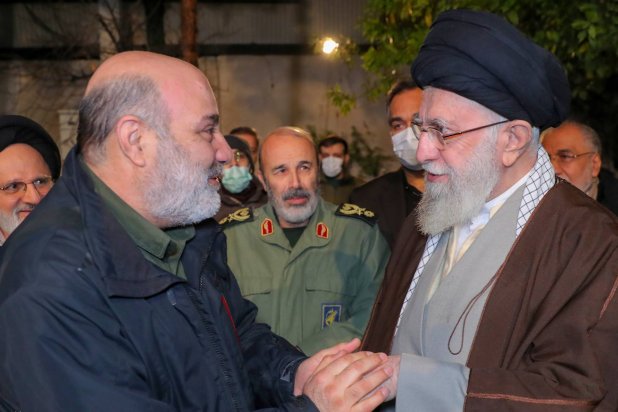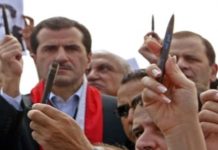Conservative Alliance in Iran: Zahedi the main planner and executor of the October 07 attack/The bodies of the Revolutionary Guard members killed in the consulate attack in Syria arrived in Tehran
London: Adel Al-Salmi/Asharq Al-Awsat/April 04, 2024
تحالف المحافظين في إيران: زاهدي المخطط والمنفذ الرئيسي لهجوم طوفان الأقصى وجثث أعضاء الحرس الثوري» القتلى بهجوم القنصلية في سوريا وصلت إلى طهران
لندن: عادل السالمي/الشرق الأوسط/04 نيسان/2024
يعدّ زاهدي أكبر خسائر «الحرس الثوري» خلال العقد الأخير بعد قاسم سليماني، وقائد قوات «الحرس الثوري» السابق في سوريا حسين همداني في حلب خلال أكتوبر 2015.
قال «تحالف القوى الثورية»؛ كبرى الجماعات المتشددة في إيران، إن الجنرال محمد رضا زاهدي، القيادي الذي قضى في غارة جوية على مجمع السفارة الإيرانية في دمشق، «المخطط والمنفذ الرئيسي» لهجوم «طوفان الأقصى» في 7 أكتوبر (تشرين الأول) الماضي.
وأصدر «تحالف القوى الثورية»؛ الإطار التنسيقي للأحزاب المحافظة، الحليف الوثيق للرئيس الإيراني إبراهيم رئيسي، بياناً يسلط فيه الضوء على أدوار زاهدي، مع وصول جثث ضباط «الحرس الثوري» إلى طهران.
ويشيد بيان «التحالف»، الذي نقلته مواقع إيرانية، بدور زاهدي في إنشاء «محور المقاومة» وتصميم عمليات «طوفان الأقصى».
وقال البيان إن «دور زاهدي الاستراتيجي في تشكيل وتعزيز (جبهة المقاومة) وكذلك تصميم وتنفيذ (طوفان الأقصى)، من المفاخر الكبيرة للجهود الصامتة لهذا القائد الكبير الخالدة في تاريخ مقاومة الاحتلال».
وأضاف البيان أن «قصف القنصلية الإيرانية في دمشق دليل على فشل وعجز قادة الكيان الصهيوني». وزاد: «على من يدعمون تل أبيب أن يعلموا أن الرد الصعب للجمهورية الإسلامية في الطريق، ومن المؤكد أنه سيؤثر على معادلات المنطقة».
وتزامن نشر البيان مع وصول جثث قتلى القنصلية الإيرانية إلى مطار مهر آباد في طهران فجر الخميس، وبثت مقطع فيديو تظهر نعوشاً منقولة بمركبة، وفق ما أفادت به وكالة الصحافة الفرنسية عن الإعلام الرسمي الإيراني. ووزع إعلام «الحرس الثوري» صوراً تظهر آثار التفجيرات على وجه قتلى «الحرس»، وذلك عشية تشييعهم في طهران.
وكانت وسائل إعلام رسمية أشارت إلى أن مراسم التشييع ستقام الجمعة تزامناً مع «يوم القدس» الذي تقام خلاله كما كل عام مظاهرة تضامنية مع الفلسطينيين ومناهضة لإسرائيل.
وخلال الشهور الماضية، نفت إيران دورها في هجوم «طوفان الأقصى»، الذي شنته حركة «حماس» على إسرائيل في 7 أكتوبر الماضي، وأشعل فتيل الأزمة والحرب التي تدور رحاها منذ 6 أشهر. واحتج وزير الخارجية الإيراني حسين أمير عبداللهيان في مناسبات عدة على وصف الجماعات المسلحة بأنها «وكلاء طهران»، مكرراً أنها لا تتلقى الأوامر من إيران.
في منتصف نوفمبر (تشرين الثاني) الماضي، نقلت وكالة «رويترز» عن مسؤولين إيرانيين وإقليميين أن المرشد الإيراني علي خامنئي قال لرئيس حركة «حماس»، إسماعيل هنية، الذي زار طهران في أوائل نوفمبر (تشرين الثاني) الماضي، إن «(حماس) لم تبلغ إيران بهجوم (7 أكتوبر) على إسرائيل، ومن ثم فإن إيران لن تدخل الحرب نيابة عنها».
وذكر التقرير؛ الذي نفته حركة «حماس» في وقت لاحق، أن خامنئي طلب من هنية إسكات المطالبين بتدخل إيران و«حزب الله».
وفي 8 أكتوبر الماضي، قال وزير الخارجية الأميركي أنتوني بلينكن: «لم نرَ حتى الآن دليلاً على أن إيران وراء هذا الهجوم».
وكان خامنئي، في 10 أكتوبر الماضي، قد نفى ضلوع بلاده في هجوم «حماس» على إسرائيل، ووصف الاتهامات الموجهة لإيران بأنها «شائعات أنصار الكيان الصهيوني» و«خطأ في الحسابات».
وقبل خطاب خامنئي بساعات، نفت وزارة الخارجية الإيرانية تقريراً نشرته صحيفة «وول ستريت جورنال» أفاد بأن ضباطاً كباراً في «الحرس الثوري» شاركوا في التخطيط لهجوم حركة «حماس» منذ أغسطس (آب) الماضي. ووصفت طهران التقرير بأنه «ذو دوافع سياسية».
ونقلت عن مصادر في «حماس» و«حزب الله» أن المسؤولين الإيرانيين أعطوا الضوء الأخضر للهجوم على إسرائيل في اجتماع عُقِد قبل أيام من الهجوم. وأشارت إلى اجتماعات أسبوعية عقدها قائد «فيلق القدس» إسماعيل قاآني مع قادة جماعات مسلحة موالية لإيران.
في 27 ديسمبر (كانون الأول) الماضي، قال المتحدث باسم «الحرس الثوري» رمضان شريف إن عملية «طوفان الأقصى كانت جزءاً من العمليات الانتقامية التي اتخذها محور المقاومة» من إسرائيل لمقتل قاسم سليماني القائد السابق لـ«فيلق القدس» الذراع الخارجية لـ«الحرس الثوري» الذي قضى بضربة أميركية في مطلع 2020.
وسارعت حركة «حماس» إلى النأي بنفسها عن رواية المتحدث باسم «الحرس». وقالت في بيان: «أكدنا مراراً دوافع وأسباب عملية (طوفان الأقصى)، وفي مقدمتها الأخطار التي تهدد المسجد الأقصى».
وفي وقت لاحق، وزَّعت وسائل إعلام «الحرس الثوري» بياناً مقتضباً يشير إلى تعديل جزئي في تصريحات المتحدث. ونقل البيان قوله إن «نتائج (طوفان الأقصى) جزء من الانتقام لاغتيال الجنرال سليماني».
وكان المتحدث باسم «الحرس» يعلق في مؤتمر صحافي على مقتل مسؤول إمدادات «الحرس الثوري» في سوريا، رضي موسوي الذي قتل بغارة جوية على منزله في منطقة السيدة زينب. وقال عضو البرلمان الإيراني، النائب مجتبى توانغر، حينها إن «موسوي لعب دوراً مهماً في تعزيز البنية التحتية لجبهة المقاومة في سوريا… يمكن أن نقول بثقة إنه من الممهدين لهجوم (طوفان الأقصى) في 7 أكتوبر الماضي».
في وقت لاحق، حاول قائد «فيلق القدس»، إسماعيل قاآني، الابتعاد عن رواية المتحدث باسم «الحرس». وقال في 30 ديسمبر إن «فصائل المقاومة في المنطقة لها هيكلية مستقلة تناسب كلاً منها (…) وجميعها اليوم صاحبة القرار والرأي».
وتابع في السياق نفسه أن «المقاومة الفلسطينية بدأت خطوتها بتدبيرها، ووضعت برنامجها بنفسها، ولأول مرة اتخذت قرارها ونفذت جميع أعمالها وفق برنامجها وتدبيرها».
ويعدّ زاهدي أكبر خسائر «الحرس الثوري» خلال العقد الأخير بعد قاسم سليماني، وقائد قوات «الحرس الثوري» السابق في سوريا حسين همداني في حلب خلال أكتوبر 2015.
“Conservative Alliance” in Iran: Zahedi the main planner and executor of the “Al-Aqsa Flood” attack/The bodies of the Revolutionary Guard members killed in the consulate attack in Syria arrived in Tehran
London: Adel Al-Salmi/Asharq Al-Awsat/April 04, 2024
(Google translation to English)
“Alliance of Revolutionary Forces,” he said; The largest extremist group in Iran said that General Mohammad Reza Zahedi, the leader who was killed in an air strike on the Iranian embassy compound in Damascus, was the “main planner and executor” of the “Al-Aqsa Flood” attack on October 7 last year.
The “Alliance of Revolutionary Forces” issued; The coordination framework of the conservative parties, a close ally of Iranian President Ebrahim Raisi, issued a statement highlighting Zahedi’s roles, with the arrival of the bodies of Revolutionary Guard officers in Tehran.
The “Coalition” statement, which was reported by Iranian websites, praises Zahedi’s role in establishing the “Axis of Resistance” and designing the “Al-Aqsa Flood” operations.
The statement said, “Zahedi’s strategic role in forming and strengthening the (Resistance Front), as well as designing and implementing (Al-Aqsa Flood), are among the great glories of the silent efforts of this great and immortal leader in the history of resistance to the occupation.”
The statement added, “The bombing of the Iranian consulate in Damascus is evidence of the failure and impotence of the leaders of the Zionist entity.” He added: “Those who support Tel Aviv should know that a difficult response from the Islamic Republic is on the way, and it will certainly affect the region’s equations.”
The publication of the statement coincided with the arrival of the dead bodies of the Iranian consulate at Mehrabad Airport in Tehran at dawn on Thursday, and a video clip was broadcast showing coffins being transported in a vehicle, according to what the French Press Agency reported from the Iranian official media. The Revolutionary Guards media distributed pictures showing the effects of the bombings on the faces of the dead Guards, on the eve of their funeral in Tehran.
Official media reported that the funeral ceremony would be held on Friday, coinciding with “Jerusalem Day,” during which, as every year, a demonstration in solidarity with the Palestinians and against Israel is held.
During the past months, Iran denied its role in the “Al-Aqsa Flood” attack, which was launched by the Hamas movement against Israel on October 7, and ignited the crisis and war that has been raging for 6 months. Iranian Foreign Minister Hossein Amir Abdollahian protested on several occasions against describing armed groups as “Tehran’s agents,” repeating that they do not receive orders from Iran.
In mid-November, Reuters quoted Iranian and regional officials as saying that Iranian Guide Ali Khamenei told the head of the Hamas movement, Ismail Haniyeh, who visited Tehran in early November, that “Hamas… Iran was not informed of the (October 7) attack on Israel, and therefore Iran will not enter the war on its behalf.”
The report stated; The Hamas movement later denied that Khamenei asked Haniyeh to silence those calling for the intervention of Iran and Hezbollah.
Last October 8, US Secretary of State Anthony Blinken said: “We have not yet seen evidence that Iran is behind this attack.”
On October 10, Khamenei denied his country’s involvement in the Hamas attack on Israel, and described the accusations against Iran as “rumors from supporters of the Zionist entity” and a “miscalculation.”
Hours before Khamenei’s speech, the Iranian Ministry of Foreign Affairs denied a report published by the Wall Street Journal, which stated that senior officers in the Revolutionary Guard had participated in planning the Hamas attack since last August. Tehran described the report as “politically motivated.”
It quoted sources in Hamas and Hezbollah that Iranian officials gave the green light to attack Israel in a meeting held days before the attack. She referred to weekly meetings held by the commander of the Quds Force, Ismail Qaani, with leaders of armed groups loyal to Iran.
On December 27, the spokesman for the Revolutionary Guards, Ramadan Sharif, said that the “Al-Aqsa Flood” operation was part of the retaliatory operations taken by the axis of resistance against Israel for the killing of Qassem Soleimani, the former commander of the Quds Force, the foreign arm of the Guards. “The Revolutionary” who was killed by an American strike in early 2020.
Hamas was quick to distance itself from the Guard spokesman’s account. She said in a statement: “We have repeatedly emphasized the motives and reasons for Operation (Al-Aqsa Flood), foremost among which are the dangers threatening Al-Aqsa Mosque.”
Later, the Revolutionary Guards media distributed a brief statement indicating a partial amendment to the speaker’s statements. The statement quoted him as saying, “The results of (Al-Aqsa Flood) are part of revenge for the assassination of General Soleimani.”
The Guards spokesman was commenting in a press conference on the killing of the Revolutionary Guards supply official in Syria, Radhi Mousavi, who was killed in an air strike on his home in the Sayyida Zeinab area. Iranian Member of Parliament, MP Mojtaba Twanger, said at the time, “Mousavi played an important role in strengthening the infrastructure of the resistance front in Syria… We can say with confidence that he was one of the initiators of the Al-Aqsa Flood attack on October 7th last year.”
Later, the commander of the Quds Force, Ismail Qaani, tried to distance himself from the account of the Guard spokesman. He said on December 30 that “the resistance factions in the region have an independent structure that suits each of them (…) and today all of them have decisions and opinions.”
In the same context, he continued, “The Palestinian resistance began its planned move, developed its own programme, and for the first time made its decision and carried out all its actions according to its program and planning.”
Zahedi is considered the greatest loss of the Revolutionary Guards during the last decade after Qassem Soleimani, and the former commander of the Revolutionary Guards forces in Syria, Hussein Hamedani, in Aleppo in October 2015.





















